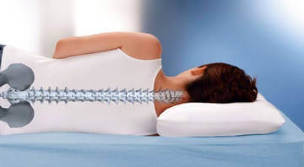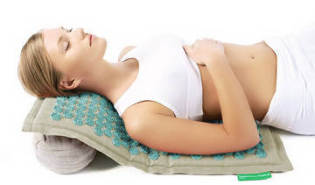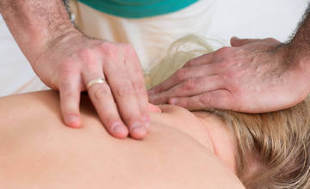
Osteochondrosis of the cervical spine is a process of progressive dystrophy, intervertebral disc disorders.
Symptoms of cervical osteochondrosis are characterized by severe pain in the neck, head, shoulders and affect everyone, regardless of age.
OSTEOCHONDROSIS DESCRIPTION
Osteochondrosis of the neck has become younger. Young people suffer from adolescence. The neck is the weakest area of the spine. The seven vertebrae are closely intertwined, and the skeletal muscles develop worse than the other parts. The neck is subjected to serious stress, as it acts as a skull brace and moves continuously.
What is cervical osteochondrosis? The intervertebral disc is fertilized by the spread of adjacent tissue. Deterioration of blood supply to the tissues around the spine causes a lack of nutrients and water. Starvation of the disc nucleus and annulus fibrosus leads to degenerative processes.
Growth of bone tissue near the vertebrae, pinched intervertebral discs, and pinched nerves and ligaments first appears as signs of decreased performance. High-intensity pain is initially concentrated in the neck, head, shoulders, heart, arms, upper chest, moving to the lower legs. Each of the seven vertebrae sends a signal to another department. Compressed nerve roots affect the state of other body systems.
Osteochondrosis is very dangerous for the brain. The vertebral arteries that run here perform the function of providing blood supply to the spinal cord. Pinching causes headaches, often develops into migraines, does not cause pain relievers. Osteochondrosis of the neck may be accompanied by dizziness, impaired vision and hearing, nausea, and vomiting. Later, the symptoms of the pharynx appear, suddenly fainting due to lack of oxygen supply to the brain. Compression of the vertebral arteries leads to ischemia of the spinal cord and brain. Deterioration of the process causes spinal stroke.
BASIC PROCESS FOR DISEASE
Osteochondrosis of the neck should be considered in terms of the interaction of physiological and pathological factors:
- physiological processes:aging of the cartilage of the spine occurs due to irreversible natural causes. Changes occur in the central part of the intervertebral disc. The process of age-related changes in the body leads to the replacement of the pulp with fibrous tissue;
- pathological processes:there are degenerative changes in the intervertebral structure, destruction of vessels and surrounding nodes. Changes occur outside the cartilage itself, there is compression of blood vessels, irritation of nerve endings. One feels dialysis, the symptoms of pain are localized and reflected.
Osteochondrosis of the cervical spine acquires a pathological form when physiological aging is replaced by pathological processes. Initially, the body's immune and protective mechanisms are triggered, eliminating the disease. Thus, osteochondrosis is able to pass or occur only sporadically. But this function is not permanent.
The progression of the disease, expressed in compression of vascular and neural structures, is accompanied by the following processes:
- spondylolisthesis, in which the spinal disc slips. Even a slight shift leads to the development of paralysis. Severe transplantation can be fatal;
- the nucleus pulposus is impregnated with calcium salts. This leads to malnutrition of the disc, provoking the formation of hernias;
- an intervertebral hernia is formed due to the protrusion of the intervertebral disc between the vertebrae. Ignoring therapeutic measures causes damp paralysis;
- the appearance of microcircles on the annulus fibrosus, expansion of protrusion. The intervertebral disc protrudes beyond its limits;
- spondylosis, which means wear of the vertebrae. Osteophytes appear - the growth of bone tissue in the form of hooks and spines, which are localized on the sides of the vertebral body. There is severe pain and, consequently, stiffness of movement.
REASONS FOR NECK OSTECHONDROSIS APPEARANCE

Increased load on the cervical spine causes the body to try to compensate for the condition. This is how muscle spasms begin, circulatory deterioration, disability. The structure of the vertebrae itself changes. The cause can also be progressive discosis as a result of prolonged physical activity.
The main factors that cause the onset of cervical osteochondrosis:
- hypodynamia;
- immune system weakness;
- excessive physical activity;
- presence of spinal cord injury;
- Nutritional deficiency of essential substances, obesity;
- problems with posture (scoliosis, flat feet, rheumatism);
- hereditary factors;
- autoimmune diseases that cause cartilage degeneration;
- stress, prolonged nervous tension;
- climate, cold and humidity factors;
- congenital anomalies in spinal space.
The leading cause of osteochondrosis is an unbalanced distribution of load on the spine, too weak a muscle corset. People over the age of thirty are at greatest risk, especially if their day is spent sitting too long.
DEVELOPMENT STAGE
The development of cervical spine osteochondrosis can be divided into several stages:
- first, preclinical.It is characterized by slight vertebral deformity, smooth cervical lordosis. Pain is felt with sudden movement of the head, fatigue occurs. The development of this disease can be prevented without medication. You need to balance your diet, choose exercise, and take preventative measures;
- sec.An unstable state is formed between the vertebrae. There is an interconnected vertebral shift, torsion - rotation around the spine. The pain increases with the movement of the neck from time to time radiating to the shoulders and arms. The height of the intervertebral disc decreases, which causes nerve pinching. It is characterized by symptoms such as irritability, fatigue, headache;
- third level.The height of the intervertebral disc is reduced by a quarter in relation to the superior disc. Defects begin to appear in the intervertebral joints. There is a decrease in the lumen of the intervertebral foramen, the spinal canal. Severe pain is felt all the time. The arm muscles begin to grow numb due to the onset of herniated intervertebral disc formation. The cervical spine loses flexibility. The patient feels dizzy, weak.
The height of the intervertebral disc is significantly reduced. The intervertebral disc is destroyed and replaced by connective tissue. Large osteophytes form in the back of the cervical spine. The spinal canal narrows very much, provoking the development of myelopathy. The patient's condition worsened, accompanied by coordination disorders, dizziness, severe pain, tinnitus.
SYMPTOMS
The description of the symptoms of a neck lesion is different from the disorder in other parts. This is due to the denser arrangement of the vertebrae with each other. Due to the small height of the intervertebral disc, the clinic began to manifest itself even with mild pathology. Signs of involvement will vary depending on which of the eight nerve roots is affected. There are nerves beneath each of the seven vertebrae, the compression of which has its own symptoms.
Problems with the first two vertebrae affect the sensitivity of the occiput. Pain is localized in the parietal, occipital area. Defeat of the third vertebral nerve endings is rare. Symptoms are manifested in numbness in the pinched area, tongue, and speech problems. The fourth root indicates a problem with pain and numbness in the collarbone, shoulder. May cause difficulty breathing, heart pain. Fifth segment disease causes pain in the shoulder, decreased limb sensitivity.
The sixth and seventh vertebral lesions are the most common among patients. Neck, shoulder blades, forearms, lower back, back suffer. There is numbness in the hands and fingers. Pathological changes in the eighth nerve root are characterized by the spread of pain in the lower leg. There is a loss of skin sensitivity, the little fingers on the hands and feet become numb. Impaired blood circulation causes the feet and hands to turn blue.Common signs of cervical osteochondrosis are:
- pain spreads to the upper body and lower body;
- weakness, decreased hand sensitivity;
- difficulty moving, cracking;
- coordination disorders, accompanied by ringing, tinnitus, disorientation, weakness, dizziness;
- nausea, vomiting;
- numbness of the tongue, fingers and toes, hearing loss, vision.
DIAGNOSTIC OSTECHONDROSIS NECK
To determine the damaged intervertebral disc and the degree of its disease, the doctor needs to perform a series of examinations: X-ray, MRI, CT (computed tomography), duplex ultrasonography scan. The most accurate method of examining the health of the cervical spine is magnetic resonance imaging (MRI). The purpose of MRI is to identify pathological changes in spinal tissues, in particular, spinal cord and intervertebral hernias. After examining and questioning the patient, performing an examination, the neurologist present makes an initial diagnosis and prescribes treatment.
TREATMENT

If you suspect osteochondrosis, you should see a neurologist. The duration of the course of therapy depends on a person's age, the severity of cervical osteochondrosis, the type of therapy, and the patient's adherence to all physician recommendations. Complete cure for serious forms of osteochondrosis is impossible. The purpose of complex treatment is to slow down the ongoing pathological process, relieving symptoms. Therapy can be conservative, surgical, or a combination of the two. If the headache becomes more frequent, then it is necessary to start therapy as early as possible.
There are two main types of treatment for cervical osteochondrosis:
- medication, carried out by taking medication;
- physiotherapy includes UHF courses, electrophoresis, ultrasound, magnetotherapy, laser therapy. They have the effect of stimulating blood flow, metabolism, and relieving muscle spasms.
To weaken the compression of the peripheral zone of the central nervous system (CNS) and to level the pain syndrome at the time of illness, drug therapy is used. After elimination of acute manifestations of cervical osteochondrosis, therapy is not stopped. Physiotherapy is prescribed. You need to massage the neck area regularly. Folk remedies are also used.
OSTEOCHONDROSIS MEDICAL THERAPY
Treatment with drugs will have a full effect only in conjunction with other methods, for example, with physiotherapy training (exercise therapy), massage. The drug is designed to relieve pain, restore cartilage tissue regeneration, and activate blood circulation in affected neck tissue.

Many doctors prescribe injections to be more effective at nerve endings. But vitamins are best taken in pill form, as injections are very painful. To give an anti-inflammatory effect, doctors perform intramuscular injections.
Main types of therapeutic drugs:
- Nonsteroidal anti-inflammatory drugs (NSAIDs).They have analgesic effects, eliminate aseptic inflammatory processes, root edema. With obvious signs of illness, injections are made twice a day with these medications. Topics using creams;
- chondroprotectors.Activates metabolism, regenerates cartilage tissue. Eliminates damage to the intervertebral disc. There are injectable drugs for the inside of the joints and muscles. The course of therapy lasts up to 4 months;
- vitamins of group B (B1, B2, B6), E, A, C, Dhelp increase metabolism in tissues, catalyze their recovery;
- muscle relaxants.For spasmodic muscle relaxation. Tablets are used in a month. In severe forms of the disease, various injectable drugs are used;
- drugs to activate blood flow in the brain,blood rheological properties.
The following is used as an adjunct to speed recovery:
- angioprotectors- a form of injectable drug designed to activate blood flow in the veins, strengthen vascular tone;
- glucocorticosteroids- to reduce edema and inflammation in the form of injections;
- biogenic stimulants.Accelerates metabolic processes, helps restore damaged tissue.
PHYSIOLOGY
Physiotherapeutic methods complement drug treatment, significantly increase recovery rates, prolong remission, and reduce the frequency of exacerbations.
Physiotherapy methods:

- Exercise therapyis one of the most effective methods of treating osteochondrosis. Regular exercise activates blood circulation, helps restore damage;
- massageimproves nerve conduction, restores muscle tone;
- magnetic therapyrelieves tissue edema;
- laser therapyacts with concentrated optical light rays. Smoothes the recovery process in the body;
- reflexology- activation of certain points. Strengthens the immune system, relieves cramps and pain in the neck;
- ultrasoundgives analgesic, anti-inflammatory effect; Electrophoresis
- with medical ingredients.An electric current drives the penetration of a drug ion into a specific place.
To get rid of cervical osteochondrosis, manual therapy, therapeutics, mud therapy are also used. All these methods slow down the progression of the disease.
It is impossible to cure osteochondrosis with herbs, but, in conjunction with primary therapy, they help alleviate the condition. Mix 2 teaspoons of bee honey with two mummy tablets. The mixture is heated, applied to a warm scarf, which is tied around the neck at night. The biostimulation properties of honey complete the treatment perfectly. To grind, use a tincture made from carrots, vodka and honey in a ratio of 1. 5: 0. 5: 1, measured in glasses. You can whip three large lemons using a meat grinder with four cloves of garlic. Pour boiling water over the mixture in a two-liter jar. After mixing the contents, drink half a glass on an empty stomach. The pain can also be overcome by heating with mustard plaster, pepper plaster.
HEALING EXERCISE
During the recovery period, you can do a set of therapeutic exercises for the neck. Exercise therapy based on some dynamic exercises. You should not do gymnastics during exacerbations. While exercising, it is recommended to monitor the appearance of discomfort, that is unacceptable.
From a cartilage position, lift your upper body using your arms. Delay for 1-2 minutes. Lower to starting position and repeat 2-3 times. Then you need to stretch the arms all over the body. Head rotation is made to the right and left 6-7 times, trying to reach the floor with the ears. Sit down. Tilt the body forward while inhaling, head tilted towards chest. While exhaling, bend backwards, throwing your head backwards. Just 10-15 tendencies. Now you need to put your palms on your forehead and put pressure together for 30 seconds. Repeat 2-3 times. Rotate your head 10 times in each direction. If your head starts to spin, exercise must be interrupted.
COMPLICATIONS

The cervical area is rich in blood vessels, the nerve endings that feed the brain. Squeezing slightly harms the whole body, interferes with blood circulation in the brain and causes neurological disorders: migraine, impaired heart function, respiratory system, vision, hearing, hypertension. Particularly dangerous are complications in the form of vertebral artery syndrome, cerebral ischemia, spinal stroke, which arise as a result of advanced neck disease. When radiculopathy occurs, mobility is lost. Spinal cord compression is fatal.
To avoid surgical intervention in the treatment of cervical osteochondrosis, one should not delay seeking medical treatment at the first sign. It is necessary to use all available methods of therapy, as well as lifestyle, dietary changes.












































